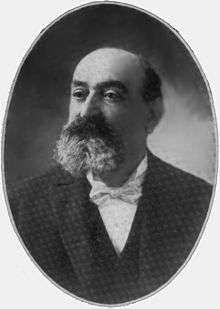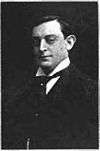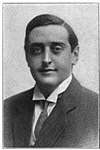Herman W. Hellman
Herman W. Hellman (1843–1906) was a German-born businessman, banker, and real estate investor in Los Angeles, California.
Herman W. Hellman | |
|---|---|
 | |
| Born | September 25, 1843 |
| Died | October 19, 1906[1] Los Angeles, California |
| Resting place | Home of Peace Cemetery |
| Occupation | Businessman, banker, real estate investor |
| Spouse(s) | Isa Heimann |
| Children | 4, including Irving Hellman |
| Relatives | Isaias W. Hellman (brother) Warren Hellman (great-grandnephew) |
Early life
Herman W. Hellman was born on September 25, 1843 in Reckendorf, Bavaria.[2][3] He emigrated to the United States with his brother Isaias W. Hellman, arriving in Los Angeles, California on May 14, 1859 as a sixteen-year-old.[2][4]
Career
He started working as a courier from Wilmington to Los Angeles for Phineas Banning.[2][5] In 1861, he worked for his uncle, Samuel Hellman, who had a store in Los Angeles.[2] Shortly after, he opened his own store at Downey Block.[2]
He established a wholesale grocer's called Hellman, Haas, & Co. with Jacob Haas, the brother of Abraham Haas.[2][3] They sold groceries in Southern California, Arizona, New Mexico and Texas.[2][3] As his business prospered, he became one of the wealthiest men in Los Angeles by the 1880s.[2] The company later became known as Baruch, Haas, & Co.[2]
In 1890, he became vice president and general manager of The Farmers and Merchants Bank of Los Angeles, a bank established by his brother.[2][3][4] He was later demoted by his brother, who found his lending practises too lenient.[2] He resigned in 1903, and became the President of the Merchants National Bank instead.[2][3][4] He also became a co-founder of the Los Angeles Chamber of Commerce.[2]
.jpg)
He was a large landowner in Los Angeles.[2] In 1903, he hired architect Alfred Rosenheim to design the Hellman Building named in his honor.[2] The eight-story building in Downtown Los Angeles still stands today, on the corner of Fourth Street (Los Angeles, California) and Spring Street (Los Angeles, California).[2][3][4]
He served as President of the Congregation B'nai B'rith, later known as the Wilshire Boulevard Temple.[2]
Personal life


He married Ida Heimann (1851-1923) who was one of his cousins, on July 26, 1874, while on a trip in Italy.[2] They resided on South Hill Street in Los Angeles and owned a secondary home in Alhambra.[2] They had five children:[6]
Death
He died of a diabetes-induced coma on October 19, 1906 in Los Angeles, California.[2][3] He was buried at the Home of Peace Cemetery in East Los Angeles.[2]
References
- "HELLMAN IS DEAD: Local Banker Dies Suddenly; Multi-Millionaire's Relatives at Bedside During His Last Moments; Attended to Vast Interests Until His Strength Gave Away; Was One of Best Known Men of Finance in Western World" (Oct 19, 1906) Los Angeles Times
- Jewish Museum of the American West: Herman W. Hellman
- H.D. Barrows (1906). "Herman W. Hellman". Tenth Annual Report of the Pioneers of Los Angeles County and the Annual Publication of the Historical Society of Southern California. University of California Press. 7 (1): 82–83. JSTOR 41168619.
- Sam Watters (December 26, 2009) "Hellman buildings were inspired by national spirit," The Los Angeles Times
- George Ward Burton (1904) Men of Achievement in the Great Southwest, p.59, Los Angeles Times
- Frances Dinkelspiel (2008) Towers of Gold: How One Jewish Immigrant Named Isaias Hellman Created California, St. Martin's Press, New York ISBN 978-0-31235-526-5